After 86 years of operation as a museum, Hagia Sophia once again welcomed Muslims longing for a connection with their god on July 24. As they said their prayers under the direction of the Imam, the leader of prayer in a mosque, they were accompanied by Turkey’s president, Recep Tayyip Erdoğan. Thousands joined the Imam and the President for prayer in Hagia Sophia to celebrate the remarkable reopening. Due to the high turnout, the crowd spilled into the redeclared mosque and across the nearby plaza and grassy area.
Before Hagia Sophia became the landmark it is today, it was repurposed multiple times as the empires and ages of history changed in its home of Istanbul. It was constructed under the rule of Greeks in the area previously known as Byzantine. Soon the city became Constantinople, and Christianity spread into the architecture of Hagia Sophia and the lands nearby. Then, in 1453, the Ottoman Turks conquered Constantinople and declared the city as Istanbul.
Christian period (Church)
Hagia Sophia was not only part of a land that was repeatedly conquered and changed throughout history; the architecture and the building itself were rebuilt and refurbished many times, too, as the religions of those who conquered it changed.
It burned down and was reconstructed twice before it became the building we know today due its original wooden construction. The most famous riot it was burned down in was the Nika Riot, which marked the end of the wooden period in Hagia Sophia as Justinian–the Emperor and head of the church during this period–hired scholars Isodore of Miletus and Anthemius of Tralles to rebuild it using stone and architect it the way it resides currently.
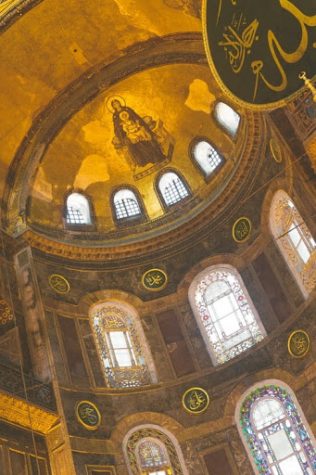
This image of the art inside the Hagia Sophia Mosque is a representation of Hagia Sophia serving as a symbol of the coexistence of Christianity and Islam. Photo by Meriç Dağlı on Unsplash.
Islamic period (Mosque)
In 1453, the Ottoman Turks conquered the empire, bringing with them the practice of Islam. Conquering Constantinople was a goal for many of the empires, the gem of the city being Hagia Sophia.
When the Ottomans conquered Constantinople, they decided to convert the church into a mosque. Despite this, the presence of the Roman Empire and Christianity is still visible today through some leftover art, however, much of it is covered by calligraphy and other Islamic art. This cover-up was not due to their disbelief in the existence of Jesus, but was in fact due to the prohibition of figurative imagery in Islam and the differing role of Jesus in the religion.
Though the conquest removed much of the Christian art, the majority of the relics and art pieces were gone before the redesign occurred. The crusaders couldn’t pay the money they owed to the Venetians, and therefore repaid their debts through art and materials from the former church. Now the pieces can be found in museums in Venice and around the world, due to their distribution over time.
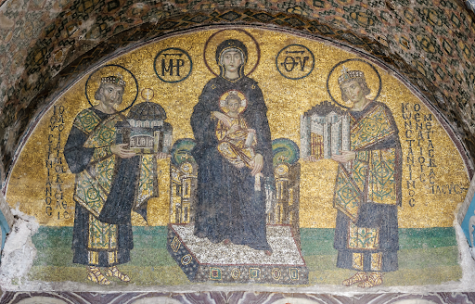 A representation of the Christian influence in the artwork. Photo by Meriç Dağlı on Unsplash.
A representation of the Christian influence in the artwork. Photo by Meriç Dağlı on Unsplash.
Architectural and Artistic Changes
After the Muslim conquering of Hagia Sophia, the building was altered to become a mosque through additions made to the architecture. The additions include plates, the Mihrab, the Sultan’s lodge, and Minarets. Architects also added the Muezzins platform, where the Imam leads the prayer.
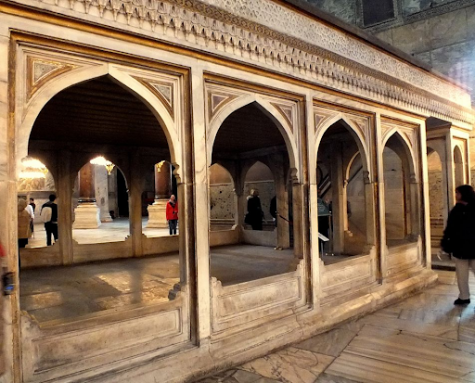
Where the Imam leads the prayer. Photo by Meriç Dağlı on Unsplash.
There are plates around Hagia Sophia with Arabic calligraphy reading the names of important figures in Islam. Arabic is the foundational language in Islam, as Muslims believe that Prophet Muhammad recited the words of God directly told to him in Arabic. The calligraphy reads as follows :
- Prophet Muhammad – known as the political leader and the founder of Islam- (Left Plate)
- Allah – God in Islam- (Center Plate)
- Imam Ali – Cousin and son-in-law of Prophet Muhammad and A respected Imam in Islam, especially in Shia Islam (Right Plate)
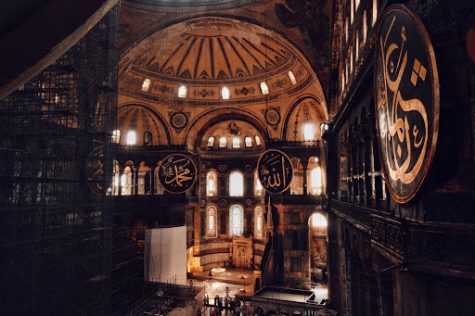
Representation of Islam in the Hagia Sophia Mosque. Photo by Abdullah Öğük on Unsplash.
The Mihrab is a mini-gate-like structure in Hagia Sophia that is towards the end of the mosque. It is off-center, as its purpose is to point towards the Holy Mecca to direct the prayer direction.
The Sultan’s lodge is an elevated surface where the Sultans of the time used to pray. It also connected to the Sultan’s balcony and personal entrance.
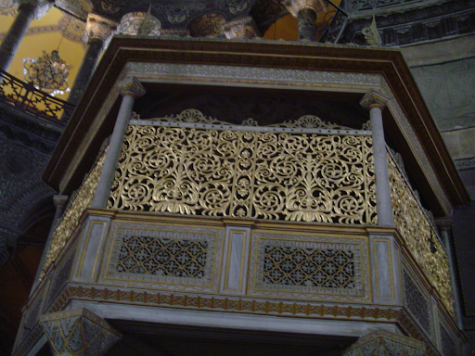
The purpose of the minarets is to allow Imams to have a high place to call people to prayer when it’s time. However, these particular minarets also signify the Ottoman invasion, as the architect that constructed these additions also constructed and designed a lot of other Ottoman architecture. Thin, pencil style minarets, typically suggest the Ottomans once settled there, as other mosques around the world have thicker minarets.
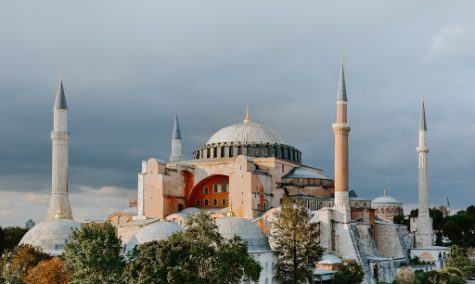
Hagia Sophia Mosque standing upright in between the land of Istanbul, Turkey with 4 minarets, 2 on each side. Photo by Adli Wahid on Unsplash.
Serving All
Hagia Sophia became a museum in 1934 and also a part of the UNESCO World Heritage Site. Mustafa Kemal Ataturk and his decree made the decision to utilize Hagia Sophia as a symbol of religious coexistence and share the history of Istanbul and Turkey as a whole to visitors from other countries.
Though it turned into a museum, the president of Turkey ultimately possesses power over the utilization of Hagia Sophia. Until now, no president had considered returning it to a mosque. President Erdoğan stated in 2019 that he was planning to restore it into a mosque, and gave his statement to the top court, who cleared the way on Friday, July 10 for the president to make the changes.
Though the prayers this Friday were mainly attended by Muslims, Hagia Sofia remains in service of both Muslims and Christians. The landmark welcomes all due to its role as a symbol of the coexistence of Chistianity and Islam and the declaration made by the current President of Turkey.














